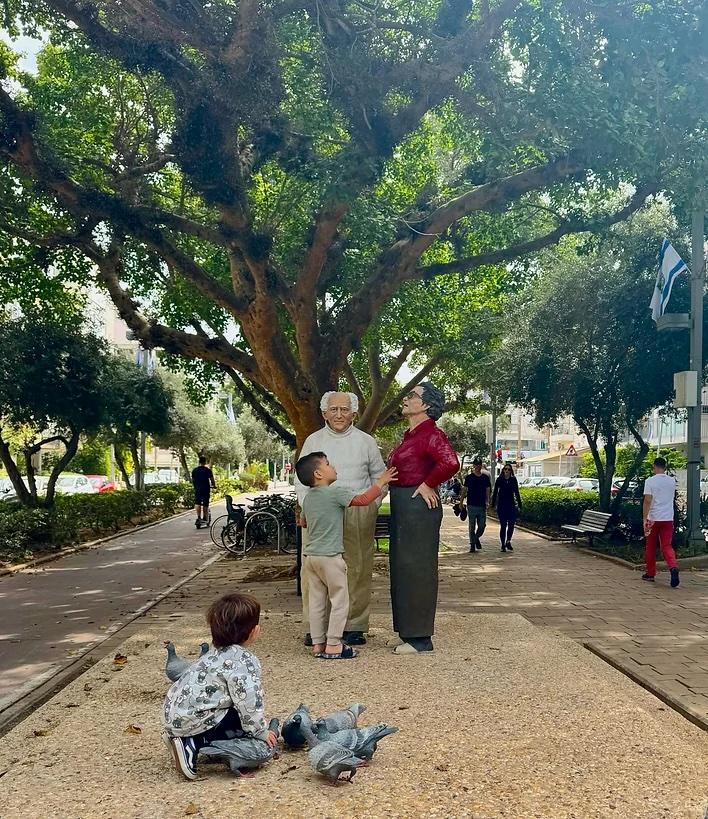The content and images in this curriculum and presentation are copyrighted and trademarked. Photographs’ subject matter is divided into categories. All photographs are by Zion Ozeri. You may only use the presentation or parts of it while implementing the DiverCity Lens in your school. For any other use, including reproduction, you must get special permission from Zion Ozeri. The use of the following content, which may be objectionable, is at your own risk, and Zion Ozeri holds no responsibility to evaluate the accuracy, completeness, and usefulness of any content provided, prior to your use. You may contact Zion Ozeri for any questions: zion@zionozeri.com
United Nations Partition Plan - Declaration of Independence
Lesson Plan by Zion Ozeri and Josh Feinberg

Ben Gurion Blvd, Tel Aviv, Israel, 2025
All images © Zion Ozeri. All Rights Reserved.
Take a close look at this photograph.
Discuss:
- What do you see in this photograph?
- What seems to be the relationship among the figures?
- What do you think is happening here?
The primary figures in this photograph are statues of David Ben-Gurion and his wife Paula. Ben-Gurion was a leader of the Zionist movement and the first Prime Minister of Israel. These statues were erected in Tel-Aviv across the street from the home where David and Paula Ben-Gurion lived. The photographer, Zion Ozeri, happened to catch these girls in the midst of playing and having fun with the sculptures.
- What is the mood of the photograph? How is that conveyed?
- How are David and Paula Ben-Gurion depicted in these statues? What is the effect? How does it compare with other statues of historical leaders youve seen?
- What do you notice about the way the girls are interacting with the statues? What does it suggest to you?
- Notice how the photographer framed this scene. Why do you think he might have framed it in the way that he did? What message might he be trying to communicate?
On May 14, 1948, David Ben-Gurion publicly read the Israeli Declaration of Independence for the first time, establishing the modern State of Israel.
Read excerpts from the Declaration below (Declaration of Israel's Independence, 1948 - American Experience - PBS):
The land of Israel was the birthplace of the Jewish people. Here their spiritual, religious and national identity was formed. Here they achieved independence and created a culture of national and universal significance. Here they wrote and gave the Bible to the world.
Exiled from Palestine, the Jewish people remained faithful to it in all the countries of their dispersion, never ceasing to pray and hope for their return and the restoration of their national freedom.
Impelled by this historic association, Jews strove throughout the centuries to go back to the land of their fathers and regain their statehood. In recent decades they returned in masses. They reclaimed the wilderness, revived their language, built cities and villages and established a vigorous and ever-growing community with its own economic and cultural life. They sought peace yet were ever prepared to defend themselves. They brought the blessing of progress to all inhabitants of the country.
In the year 1897 the First Zionist Congress, inspired by Theodor Herzl's vision of the Jewish State, proclaimed the right of the Jewish people to national revival in their own country.
This right was acknowledged by the Balfour Declaration of November 2, 1917, and re-affirmed by the Mandate of the League of Nations, which gave explicit international recognition to the historic connection of the Jewish people with Palestine and their right to reconstitute their National Home.
On November 29, 1947, the General Assembly of the United Nations adopted a Resolution for the establishment of an independent Jewish State in Palestine, and called upon the inhabitants of the country to take such steps as may be necessary on their part to put the plan into effect.
THE STATE OF ISRAEL will be open to the immigration of Jews from all countries of their dispersion; will promote the development of the country for the benefit of all its inhabitants; will be based on the precepts of liberty, justice and peace taught by the Hebrew Prophets; will uphold the full social and political equality of all its citizens, without distinction of race, creed or sex; will guarantee full freedom of conscience, worship, education and culture; will safeguard the sanctity and inviolability of the shrines and Holy Places of all religions; and will dedicate itself to the principles of the Charter of the United Nations.
Our call goes out to the Jewish people all over the world to rally to our side in the task of immigration and development and to stand by us in the great struggle for the fulfillment of the dream of generations - the redemption of Israel.
With trust in Almighty God, we set our hand to this Declaration, at this Session of the Provisional State Council, in the city of Tel Aviv, on this Sabbath eve, the fifth of Iyar, 5708, the fourteenth day of May, 1948.
Discuss:
- What do you notice about the way the document begins? Why do you think the writers began with so much history?
- This document founded Israel as both a Jewish state and a democracy. How are these two aspects of the country established or described here?
- Compare the Israeli Declaration of Independence with the American Declaration of Independence. How are they similar? How are they different? To what do you attribute the differences?
- The document notes that the United Nations had already adopted a resolution that included the establishment of a Jewish State. Why was it important to include that in the Declaration of Independence? Why do you think its important to have a Declaration of Independence at all?
- The Declaration calls on Jews around the world to rally to our side. What do you think was meant by that? What is the responsibility of worldwide Jewry to the State of Israel?
- How do you think it might have felt to hear this Declaration for the first time as a Jew in 1948?
For more information:
Declaration of Independence -The Knesset
David Ben-Gurion | My Jewish Learning
General Assembly - Question of Palestine - UN
UN General Assembly Resolution 181- Israel Ministry of Foreign Affairs
Follow-up activities:
- Take a photograph of a statue in your neighborhood, or city, that reflects your feelings towards the person depicted by the artist.
Optional:
- Imagine you were creating a new country from scratch. What ideals and values would you want it to reflect? What principles would guide its affairs? Craft a Declaration of Independence for your new nation.
